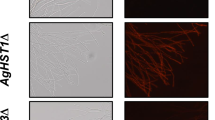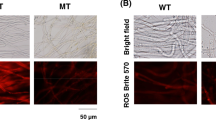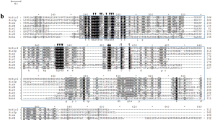Abstract
This study focuses on sirtuins, which catalyze the reaction of NAD+-dependent protein deacetylase, for riboflavin production in A. gossypii. Nicotinamide, a known inhibitor of sirtuin, made the color of A. gossypii colonies appear a deeper yellow at 5 mM. A. gossypii has 4 sirtuin genes (AgHST1, AgHST2, AgHST3, AgHST4) and these were disrupted to investigate the role of sirtuins in riboflavin production in A. gossypii. AgHST1∆, AgHST3∆, and AgHST4∆ strains were obtained, but AgHST2∆ was not. The AgHST1∆ and AgHST3∆ strains produced approximately 4.3- and 2.9-fold higher amounts of riboflavin than the WT strain. The AgHST3∆ strain showed a lower human sirtuin 6 (SIRT6)-like activity than the WT strain and only in the AgHST3∆ strain was a higher amount of acetylation of histone H3 K9 and K56 (H3K9ac and H3K56ac) observed compared to the WT strain. These results indicate that AgHst3 is SIRT6-like sirtuin in A. gossypii and the activity has an influence on the riboflavin production in A. gossypii. In the presence of 5 mM hydroxyurea and 50 µM camptothecin, which causes DNA damage, especially double-strand DNA breaks, the color of the WT strain colonies turned a deeper yellow. Additionally, hydroxyurea significantly led to the production of approximately 1.5 higher amounts of riboflavin and camptothecin also enhanced the riboflavin production even through the significant difference was not detected. Camptothecin tended to increase the amount of H3K56ac, but the amount of H3K56ac was not increased by hydroxyurea treatment. This study revealed that AgHst1 and AgHst3 are involved in the riboflavin production in A. gossypii through NAD metabolism and the acetylation of H3, respectively. This new finding is a step toward clarifying the role of sirtuins in riboflavin over-production by A. gossypii.
Key points
• Nicotinamide enhanced the riboflavin production in Ashbya gossypii.
• Disruption of AgHST1 or AgHST3 gene also enhanced the riboflavin production in Ashbya gossypii.
• Acetylation of H3K56 led to the enhancement of the riboflavin production in Ashbya gossypii.




Similar content being viewed by others
Data availability
All data analyzed in this study are shown in this published article including its supplementary information files.
References
Anderson KA, Madsen AS, Olsen CA, Hirschey MD (2017) Metabolic control by sirtuins and other enzymes that sense NAD+, NADH, or their ratio. Biochim Biophys Acta Bioenerg 1858:991–998. https://doi.org/10.1016/j.bbabio.2017.09.005
Avalos JL, Bever KM, Wolberger C (2005) Mechanism of sirtuin inhibition by nicotinamide: altering the NAD+ cosubstrate specificity of a Sir2 enzyme. Mol Cell 17:855–868. https://doi.org/10.1016/j.molcel.2005.02.022
Barja G (2019) Towards a unified mechanistic theory of aging. Exp Gerontol 124:110627. https://doi.org/10.1016/j.exger.2019.05.016
Bedalov A, Hirao M, Posakony J, Nelson M, Simon JA (2003) NAD+-dependent deacetylase Hst1p controls biosynthesis and cellular NAD+ levels in Saccharomyces cerevisiae. Mol Cell Biol 23:7044–7054. https://doi.org/10.1128/mcb.23.19.7044-7054.2003
Bosch-Presegué L, Vaquero A (2015) Sirtuin-dependent epigenetic regulation in the maintenance of genome integrity. FEBS J 282:1745–1767. https://doi.org/10.1111/febs.13053
Breitenbach M, Laun P, Dickinson JR, Klocker A, Rinnerthaler M, Dawes IW, Aung-Htut MT, Breitenbach-Koller L, Caballero A, Nyström T, Büttner S, Eisenberg T, Madeo F, Ralser M (2012) The role of mitochondria in the aging processes of yeast. Subcell Biochem 57:55–78. https://doi.org/10.1007/978-94-007-2561-43
Casatta N, Porro A, Orlandi I, Brambilla L, Vai M (2013) Lack of Sir2 increases acetate consumption and decreases extracellular pro-aging factors. Biochim Biophys Acta 1833:593–601. https://doi.org/10.1016/j.bbamcr.2012.11.008
Celic I, Verreault A, Boeke JD (2008) Histone H3 K56 hyperacetylation perturbs replisomes and causes DNA damage. Genetics 179:1769–1784. https://doi.org/10.1534/genetics.108.088914
Dietrich FS, Voegeli S, Brachat S, Lerch A, Gates K, Steiner S, Mohr C, Pöhlmann R, Luedi P, Choi S, Wing RA, Flavier A, Gaffney TD, Philippsen P (2004) The Ashbya gossypii genome as a tool for mapping the ancient Saccharomyces cerevisiae genome. Science 304:304–307. https://doi.org/10.1126/science.1095781
Dubacq C, Chevalier A, Courbeyrette R, Petat C, Gidrol X, Mann C (2006) Role of the iron mobilization and oxidative stress regulons in the genomic response of yeast to hydroxyurea. Mol Genet Genomics 275:114–124. https://doi.org/10.1007/s00438-005-0077-5
Etchegaray JP, Mostoslavsky R (2016) Interplay between metabolism and epigenetics: a nuclear adaptation to environmental changes. Mol Cell 62:695–711. https://doi.org/10.1016/j.molcel.2016.05.029
Fiorino E, Giudici M, Ferrari A, Mitro N, Caruso D, De Fabiani E, Crestani M (2014) The sirtuin class of histone deacetylases: regulation and roles in lipid metabolism. IUBMB Life 66:89–99. https://doi.org/10.1002/iub.1246
Gudipati V, Koch K, Lienhart WD, Macheroux P (2014) The flavoproteome of the yeast Saccharomyces cerevisiae. Biochim Biophys Acta 1844:535–544. https://doi.org/10.1016/j.bbapap.2013.12.015
Jeong BY, Wittmann C, Kato T, Park EY (2015) Comparative metabolic flux analysis of an Ashbya gossypii wild type strain and a high riboflavin-producing mutant strain. J Biosci Bioeng 119:101–106. https://doi.org/10.1016/j.jbiosc.2014.06.014
Jimenez A, Santos MA, Pompejus M, Revuelta JL (2005) Metabolic engineering of the purine pathway for riboflavin production in Ashbya gossypii. Appl Environ Microbiol 71:5743–5751. https://doi.org/10.1128/AEM.71.10.5743-5751.2005
Jimenez A, Santos MA, Revuelta JL (2008) Phosphoribosyl pyrophosphate synthetase activity affects growth and riboflavin production in Ashbya gossypii. BMC Biotechnol 8:67. https://doi.org/10.1186/1472-6750-8-67
Kaeberlein M, McVey M, Guarente L (1999) The SIR2/3/4 complex and SIR2 alone promote longevity in Saccharomyces cerevisiae by two different mechanisms. Genes Dev 13:2570–2580. https://doi.org/10.1101/gad.13.19.2570
Kato T, Park EY (2006) Expression of alanine:glyoxylate aminotransferase gene from Saccharomyces cerevisiae in Ashbya gossypii. Appl Microbiol Biotechnol 71:46–52. https://doi.org/10.1007/s00253-005-0124-5
Kato T, Azegami J, Yokomori A, Dohra H, El Enshasy HA, Park EY (2020) Genomic analysis of a riboflavin-overproducing Ashbya gossypii mutant isolated by disparity mutagenesis. BMC Genomics 21:319. https://doi.org/10.1186/s12864-020-6709-7
Konada L, Aricthota S, Vadla R, Haldar D (2018) Fission yeast sirtuin Hst4 functions in preserving genomic integrity by regulating replisome component Mcl1. Sci Rep 8:8496. https://doi.org/10.1038/s41598-018-26476-4
Ledesma-Amaro R, Serrano-Amatriain C, Jiménez A, Revuelta JL (2015) Metabolic engineering of riboflavin production in Ashbya gossypii through pathway optimization. Microb Cell Fact 14:163. https://doi.org/10.1186/s12934-015-0354-x
Li M, Valsakumar V, Poorey K, Bekiranov S, Smith JS (2013) Genome-wide analysis of functional sirtuin chromatin targets in yeast. Genome Biol 14:R48. https://doi.org/10.1186/gb-2013-14-5-r48
Lin Y, Lu J, Zhang J, Walter W, Dang W, Wan J, Tao SC, Qian J, Zhao Y, Boeke JD, Berger SL, Zhu H (2009) Protein acetylation microarray reveals that NuA4 controls key metabolic target regulating gluconeogenesis. Cell 136:1073–1084. https://doi.org/10.1016/j.cell.2009.01.033
Madsen CT, Sylvestersen KB, Young C, Larsen SC, Poulsen JW, Andersen MA, Palmqvist EA, Hey-Mogensen M, Jensen PB, Treebak JT, Lisby M, Nielsen ML (2015) Biotin starvation causes mitochondrial protein hyperacetylation and partial rescue by the SIRT3-like deacetylase Hst4p. Nat Commun 6:7726. https://doi.org/10.1038/ncomms8726
Masumoto H, Hawke D, Kobayashi R, Verreault A (2005) A role for cell-cycle-regulated histone H3 lysine 56 acetylation in the DNA damage response. Nature 436:294–298. https://doi.org/10.1038/nature03714
Mateos L, Jimenez A, Revuelta JL, Santos MA (2006) Purine biosynthesis, riboflavin production, and trophic-phase span are controlled by a Myb-related transcription factor in the fungus Ashbya gossypii. Appl Environ Microbiol 72:5052–5060. https://doi.org/10.1128/AEM.00424-06
Miller KM, Tjeertes JV, Coates J, Legube G, Polo SE, Britton S, Jackson SP (2010) Human HDAC1 and HDAC2 function in the DNA-damage response to promote DNA nonhomologous end-joining. Nat Struct Mol Biol 17:1144–1151. https://doi.org/10.1038/nsmb.1899
Orlandi I, Alberghina L, Vai M (2020) Nicotinamide, nicotinamide riboside and nicotinic acid-emerging roles in replicative and chronological aging in yeast. Biomolecules 10:604. https://doi.org/10.3390/biom10040604
Park EY, Ito Y, Nariyama M, Sugimoto T, Lies D, Kato T (2011) The improvement of riboflavin production in Ashbya gossypii via disparity mutagenesis and DNA microarray analysis. Appl Microbiol Biotechnol 91:1315–1326. https://doi.org/10.1007/s00253-011-3325-0
Petermann E, Orta ML, Issaeva N, Schultz N, Helleday T (2010) Hydroxyurea-stalled replication forks become progressively inactivated and require two different RAD51-mediated pathways for restart and repair. Mol Cell 37:492–502. https://doi.org/10.1016/j.molcel.2010.01.021
Pinson B, Ceschin J, Saint-Marc C, Daignan-Fornier B (2019) Dual control of NAD+ synthesis by purine metabolites in yeast. Elife 8:e43808. https://doi.org/10.7554/eLife.43808
Puddu F, Salguero I, Herzog M, Geisler NJ, Costanzo V, Jackson SP (2017) Chromatin determinants impart camptothecin sensitivity. EMBO Rep 18:1000–1012. https://doi.org/10.15252/embr.201643560
Revuelta JL, Ledesma-Amaro R, Lozano-Martinez P, Díaz-Fernández D, Buey RM, Jiménez A (2017) Bioproduction of riboflavin: a bright yellow history. J Ind Microbiol Biotechnol 44:659–665. https://doi.org/10.1007/s10295-016-1842-7
Saka K, Ide S, Ganley ARD, Kobayashi T (2013) Cellular senescence in yeast is regulated by rDNA noncoding transcription. Curr Biol 23:1794–1798. https://doi.org/10.1016/j.cub.2013.07.048
Schwechheimer SK, Park EY, Revuelta JL, Becker J, Wittmann C (2016) Biotechnology of riboflavin. Appl Microbiol Biotechnol 100:2107–2119. https://doi.org/10.1007/s00253-015-7256-z
Silva R, Aguiar TQ, Oliveira R, Domingues L (2019) Light exposure during growth increases riboflavin production, reactive oxygen species accumulation and DNA damage in Ashbya gossypii riboflavin-overproducing strains. FEMS Yeast Res 19: foy114. https://doi.org/10.1093/femsyr/foy114
Simoneau A, Delgoshaie N, Celic I, Dai J, Abshiru N, Costantino S, Thibault P, Boeke JD, Verreault A, Wurtele H (2015) Interplay between histone H3 lysine 56 deacetylation and chromatin modifiers in response to DNA damage. Genetics 200:185–205. https://doi.org/10.1534/genetics.115.175919
Singh A, Xu JY (2016) The cell killing mechanisms of hydroxyurea. Genes (basel) 7:99. https://doi.org/10.3390/genes7110099
Sugimoto T, Kanamasa S, Kato T, Park EY (2009) Importance of malate synthase in the glyoxylate cycle of Ashbya gossypii for the efficient production of riboflavin. Appl Microbiol Biotechnol 83:529–539. https://doi.org/10.1007/s00253-009-1972-1
Sun SY (2010) N-acetylcysteine, reactive oxygen species and beyond. Cancer Biol Ther 9:109–110. https://doi.org/10.4161/cbt.9.2.10583
Tajima S, Itoh Y, Sugimoto T, Kato T, Park EY (2009) Increased riboflavin production from activated bleaching earth by a mutant strain of Ashbya gossypii. J Biosci Bioeng 108:325–329. https://doi.org/10.1016/j.jbiosc.2009.04.021
Walther A, Wendland J (2012) Yap1-dependent oxidative stress response provides a link to riboflavin production in Ashbya gossypii. Fungal Genet Biol 49:697–707. https://doi.org/10.1016/j.fgb.2012.06.006
Wendland J, Ayad-Durieux Y, Knechtle P, Rebischung C, Philippsen P (2000) PCR-based gene targeting in the filamentous fungus Ashbya gossypii. Gene 242:381–391. https://doi.org/10.1016/s0378-1119(99)00509-0
Wierman MB, Smith JS (2014) Yeast sirtuins and the regulation of aging. FEMS Yeast Res 14:73–88. https://doi.org/10.1111/1567-1364.12115
Yamada S, Ohta K, Yamada T (2013) Acetylated Histone H3K9 is associated with meiotic recombination hotspots, and plays a role in recombination redundantly with other factors including the H3K4 methylase Set1 in fission yeast. Nucleic Acids Res 41:3504–3517. https://doi.org/10.1093/nar/gkt049
Yuan J, Pu M, Zhang Z, Lou Z (2009) Histone H3–K56 acetylation is important for genomic stability in mammals. Cell Cycle 8:1747–1753. https://doi.org/10.4161/cc.8.11.8620
Zhang F, Kirouac M, Zhu N, Hinnebusch AG, Rolfes RJ (1998) Evidence that complex formation by Bas1p and Bas2p (Pho2p) unmasks the activation function of Bas1p in an adenine-repressible step of ADE gene transcription. Mol Cell Biol 17:3272–3283. https://doi.org/10.1128/mcb.17.6.3272
Zhu Q, Battu A, Ray A, Wani G, Qian J, He J, Wang Q, Wani AA (2015) Damaged DNA-binding protein down-regulates epigenetic mark H3K56Ac through histone deacetylase 1 and 2. Mutat Res 776:16–23. https://doi.org/10.1016/j.mrfmmm.2015.01.005
Funding
This work was supported by JSPS KAKENHI (Grant-in-Aid for Scientific Research (C) Grant Number JP21K05390).
Author information
Authors and Affiliations
Contributions
TK, HAE, and EYP conceived and designed this research and the experiments. JA and MK performed all experiments. TK, HAE, and EYP wrote this manuscript. All authors read and approved the final manuscript.
Corresponding author
Ethics declarations
Ethical approval
The authors declare that no human participants or animals were used for the purpose of this study.
Competing interests
The authors declare no competing interests.
Additional information
Publisher's note
Springer Nature remains neutral with regard to jurisdictional claims in published maps and institutional affiliations.
Supplementary Information
Below is the link to the electronic supplementary material.
Rights and permissions
About this article
Cite this article
Kato, T., Azegami, J., Kano, M. et al. Effects of sirtuins on the riboflavin production in Ashbya gossypii. Appl Microbiol Biotechnol 105, 7813–7823 (2021). https://doi.org/10.1007/s00253-021-11595-2
Received:
Revised:
Accepted:
Published:
Issue Date:
DOI: https://doi.org/10.1007/s00253-021-11595-2




